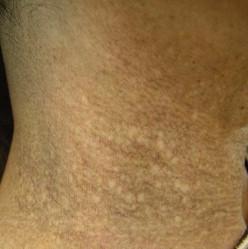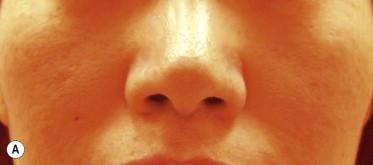Physical Address
304 North Cardinal St.
Dorchester Center, MA 02124
Photoaging-related mottled pigmentation is a common manifestation associated with other dermatoses, including solar lentigines and melasma.
Combination treatments must be individualized to each patient based on the pattern and cause of the pigmentation.
Treatment targets are broadly divided into epidermal pigmentation and dermal pigmentation. Vascular changes in the dermis can be important additional treatment targets.
Q-switched lasers with a pulse duration of nanoseconds are suitable for selectively targeting melanin and provide effective treatment.
Intense pulsed light can affect mottled pigmentation because of its effect on vascular changes and pigmentation abnormalities.
It is desirable to use topical agents, including tretinoin.
Other treatment options include fractional lasers, pulsed-dye lasers, and oral tranexamic acid.
Historically, the term “mottled pigmentation” has been used to describe a form of epidermolysis bullosa simplex called epidermolysis bullosa simplex with mottled pigmentation that presents with irregular and reticular hyperpigmentation. More recently, the term has been used to describe a dermatologic manifestation associated with different dermatologic conditions in which the skin becomes discolored in uneven patches.
Photoaging is a term used to describe the changes in the skin induced by long-term exposure to ultraviolet (UV) light. Mottled pigmentation (dyspigmentation), wrinkles, and solar lentigines are well-documented changes associated with photoaging. Chronic exposure to UV light appears to be a primary etiologic factor in the development of mottled pigmentation. Photoaging-related mottled pigmentation mainly manifests as poikiloderma of the neck or irregular hyper- and hypopigmentation on the faces of older women ( Fig. 50.1 ).

Mottled pigmentation is also observed in association with various skin conditions. For example, poikiloderma is a morphologic term referring to a combination of atrophy, telangiectasia, and various pigmentary changes (hyper- and hypopigmentation) over an area of skin. In addition, melasma is characterized by irregular hyperpigmentation, and even normal-looking faces show irregular skin discolorations when examined using a Wood's lamp ( Fig. 50.2 ). Therefore, when managing this condition, it is critical to consider the different manifestations of photoaging-related mottled pigmentation and their association with other dermatoses.

In this chapter, we review the pathogenesis, clinical assessment, and treatment of photoaging-related mottled pigmentation.
The pathogenesis of photoaging-related mottled pigmentation remains unclear. Although no large studies have investigated the genetic background of this condition, it is suspected that individuals may be genetically predisposed to conditions associated with photoaging-related mottled pigmentation, for example, melasma or acquired bilateral nevus of Ota-like macules (ABNOM). Hormones are another important factor influencing the development of melasma, and it is thought that sex hormones may be involved in photoaging-related mottled pigmentation.
Sun exposure also affects the development and aggravation of melasma. Although long-term sun exposure increases the number of active melanocytes during photoaging, the average density of epidermal melanocytes decreases by approximately 10% per decade during chronological aging. Thus, photoaging-related mottled pigmentation is a consequence of the combined effects of chronological aging and photoaging.
Sun exposure triggers the production of cytokines and growth factors by keratinocytes, including endothelin-1, alpha-melanocyte-stimulating hormone, and adrenocorticotropic hormone, which upregulate melanocyte proliferation and melanogenesis. Consequently, the cumulative effects of UV radiation, including oxidative DNA damage and its impact on paracrine factors, may affect the development of mottled pigmentation.
Wrinkles are a characteristic feature of photoaging. Many studies have investigated the relationship between UV radiation and subsequent wrinkle formation. Solar elastosis refers to the degeneration of elastic materials in the dermis as a result of the cumulative effects of prolonged and excessive sun exposure.
Interactions between melanocytes and the adjacent skin cells, such as the keratinocytes in the epidermis and the fibroblasts in the dermis, are important in the regulation of melanocyte function and subsequent skin pigmentation. Many paracrine factors secreted from the fibroblasts, for example, stem cell factor (SCF) and hepatocyte growth factor, are involved in regulating skin pigmentation after sun exposure. Furthermore, it has been suggested that dermal factors, for example, vascularity and melanogenic paracrine networks, which include the SCF/c-kit pathway, are involved in the pathogenesis of melasma and ABNOM.
Pigmentary skin conditions, including photoaging-related mottled pigmentation, appear to have similar pathogenic mechanisms and frequently recur even after chemical peeling. Therefore, it can be hypothesized that dermal changes induced by constant sun exposure play a vital role in these conditions.
The cutaneous vasculature has an important influence on the development of pigmentation. Pronounced telangiectatic erythema is commonly observed in areas of mottled pigmentation. UV radiation promotes angiogenesis; therefore, vascular changes may be an epiphenomenon arising from the accumulated effects of long-term UV exposure. Nevertheless, an increase in vascularity may also play a major role in the development of pigmentation. This hypothesis is supported by a recent study that found increased numbers of enlarged blood vessels and significantly increased levels of vascular endothelial growth factor (VEGF) expression in areas of skin affected by melasma. The study authors suggested that in addition to being a major angiogenic factor that modifies blood vessels in melasma, VEGF also affects melanogenesis. Because VEGF stimulates the release of arachidonic acid, and the phosphorylation and activation of cytosolic phospholipase A 2 , it may have a direct impact on melanocyte behavior through its receptor on normal human melanocytes.
No standardized method is available to assess mottled pigmentation. Dover's modified global photodamage severity score includes mottled pigmentation as a change associated with photoaging ( Box 50.1 ). Another scoring method assesses mottled pigmentation at different levels:
0: evenly pigmented skin
1: small areas of light hypo- or hyperpigmentation
2: small areas of moderate hypo- or hyperpigmentation, or medium-sized areas of light hypo- or hyperpigmentation
3: medium-sized areas of moderate hypo- or hyperpigmentation, or small areas of heavy hypo- or hyperpigmentation
4: marked hypo- or hyperpigmentation.
0: Skin smooth to the touch without significant fine lines, coarse lines, erythema, telangiectasia, sebaceous hyperplasia, or unevenness in pigmentation in any of the facial areas (cheeks, forehead, and the perioral area)
1: Facial skin (on the cheeks, forehead, or the perioral area) shows 1 area of significant roughness, coarse lines, erythema, telangiectasia, sebaceous hyperplasia, dyspigmentation (hypopigmentation or hyperpigmentation), or fine lines
2: Facial skin (on the cheeks, forehead, or the perioral area) shows 2 areas of significant roughness, coarse lines, erythema, telangiectasia, sebaceous hyperplasia, dyspigmentation, or fine lines; or shows roughness, coarse lines, erythema, telangiectasia, sebaceous hyperplasia, dyspigmentation, and fine lines in 1 area
3: Facial skin (on the cheeks, forehead, or the perioral area) shows 3 areas with significant roughness, coarse lines, erythema, telangiectasia, sebaceous hyperplasia, dyspigmentation, or fine lines; or shows roughness, coarse lines, erythema, telangiectasia, sebaceous hyperplasia, dyspigmentation, and fine lines in 2 areas
4: Facial skin shows any degree of photodamage greater than level 3.
Variations in cutaneous photodamage occur according to ethnic background and sex. For example, in Asians, pigmentary change is prominent. Various photographic scales attempt to standardize the grading of photodamage severity. Among these, Chung and colleagues developed a photographic scale to assess the influence of sex, sun exposure, smoking, and skin color on dyspigmentation in Korean people.
The melasma area and severity index (MASI) can be used as a standard method for assessing pigmentary changes, and it evaluates both the area and severity of pigmentation. This index is calculated by first assessing the hyperpigmented area (A) of the face. The whole face is divided into 4 areas (forehead, right malar region, left malar region, and chin, corresponding to 30%, 30%, 30%, and 10% of the total face, respectively). Then, the percentages of the involved areas are estimated using a 6-point scale: 1, <10%; 2, 10–29%, 3, 30–49%; 4, 50–69%; 5, 70–89%; 6, 90–100%. The grade of pigmentation is determined based on two variables (darkness (D) of pigment and homogeneity (H)). D is valued in each region on a scale of 0 (absent) to 4 (severe), and H on a scale of 0 (minimal) to 4 (maximum). Then, the MASI score is calculated by the sum of severity value for D and H that is multiplied by the rating of A; the maximum score is 48 and the minimum 0.
(A, area; D, darkness; H, homogeneity of hyperpigmentation; c, chin; f, forehead; ml, left malar; mr, right malar)
Become a Clinical Tree membership for Full access and enjoy Unlimited articles
If you are a member. Log in here